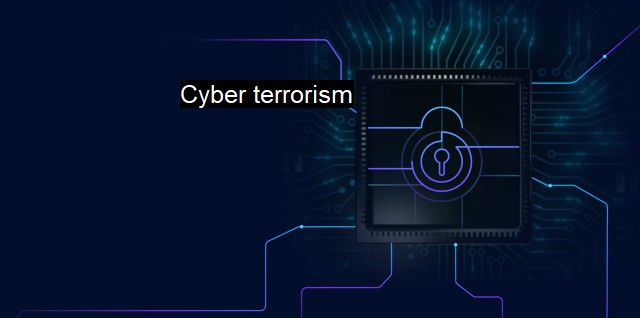What is Cyber terrorism?
Combatting Cyberterrorism: Understanding the Growing Threat of Cyberattacks, their Impact and How to Prevent Them
Cyber terrorism, a term part of the larger domain of cybersecurity, refers to the disruptive activities of endorsing political objectives, religious fanaticism, or heinous intent. The modus operandi used in these activities intend to undermine, deface anonymous networks, steal critical personal or financial data, damaging critical cyber infrastructures, and causing havoc in the lives of countless users across global boundaries.Cyberterrorism is broadly categorized into two types: in the first, computer systems are manipulated to carry out catastrophic physical destruction; in the second, computer systems, networks, and data of individuals, small companies, and large corporations are violated to disrupt their normal functioning.
The threat from cyber terrorism is real and prominent, and it extends far beyond simple hacking or mischief. Cyber terrorists can cripple national defence systems, disrupt crucial public services, and cause incalculable economic damage, reaching much farther into a society than traditional terrorists with bombs and bullets. As our reliance on information technology increases, protecting these IT infrastructures from this form of terrorism is ever more crucial.
Utilising sophisticated hacking techniques, cyber terrorists can infiltrate absolutely anything from your surveillance cameras to nuclear power plants with the mere intention to cause great harm: economic disruptions, political ripple effects, and even mass human casualties. A typical example of large scale cyberterrorism was the Stuxnet worm, which destroyed a fifth of Iran's nuclear centrifuges, in 2010.
The magnitude of cyber terrorism is such that it is capable of destroying countries and causing worldwide chaos, and as our digital imprint grows through the internet of things (IoT), the vulnerabilities exposed add up to magnify this issue further. Cyber terrorists are continuously evolving, using the latest technology and capitalising on human, technological, and system vulnerabilities.
In this light, the role of cybersecurity and antivirus protection in mitigating cyber terrorism cannot be overemphasized. Cybersecurity focuses on the protection of computer systems from cyber threats, be it data theft, impersonation, violation of privacy, cyber stalking or cyber terrorism. The strategic measures used to proactively combat cyber threats include secure coding practices, routine checking, network surveillance, educational training and high-level algorithms to identify vulnerabilities associated with cyber terrorism.
One way to bolstering cybersecurity is through a comprehensive antivirus solution which can detect, prevent, and respond to varying levels of online threats. Antivirus software essentially provides a shield for your devices, protecting them against numerous potential cyber threats. They contain intentionally malicious rules, pervasively deceive end users, and can literally damage any system without adequate protection.
It's important to adopt an extensive coverage antivirus which doesn't simply focus on a single type of threat but numerous types: malware, spyware, viral infections, Trojan viruses etc. This robust type of antivirus software can identify even the most concealed threats and illicit software.
Keep in-app software upgrades up-to-date as they rectify protection vulnerabilities. Always have an operational firewall as it places a barrier with solid security controls between the trusted internal networks and unreliable external networks. Encryption too is a valuable tool that makes personal information unreadable to cyber terrorists.
Cyberterrorism is a serious issue that undermines the security, technology, businesses, government entities, and incalculable lives around the globe. The need for strong cybersecurity measures, aided by comprehensive antivirus software, operational firewall, and encryption, is of exceeding exigency. While it is noble to continuously try improving technology, it is clearly integral to couple that with effective defenses that keep cyber terrorists at bay, ensuring our virtual walls never crumble under the attempted demolition of cyber terrorism.

Cyber terrorism FAQs
What is cyber terrorism?
Cyber terrorism is the use of technology, particularly the internet, to carry out deliberate and large-scale attacks that can cause harm, fear, or panic among people. These attacks are often aimed at damaging critical infrastructure, disrupting essential services, or stealing sensitive data.What are the common tactics used in cyber terrorism?
Cyber terrorists often use a variety of tactics such as malware, phishing, denial-of-service attacks, and social engineering to gain access to target networks or systems. They may also use advanced persistent threats (APT) to gain access to sensitive information or disrupt critical systems.What are the impacts of cyber terrorism?
The impacts of cyber terrorism can be severe and far-reaching. They can cause damage to critical infrastructure, disrupt essential services, and steal sensitive data. Cyber terrorism can also result in financial losses, reputational damage, and loss of human lives in extreme cases.What can be done to prevent cyber terrorism?
Preventing cyber terrorism requires a multi-layered approach that includes robust cybersecurity measures, regular updates and patches, employee training and awareness, and collaboration between governments and private organizations. It is also important to have effective incident response plans in place to quickly detect and respond to cyber attacks.| | A | | | B | | | C | | | D | | | E | | | F | | | G | | | H | | | I | | | J | | | K | | | L | | | M | |
| | N | | | O | | | P | | | Q | | | R | | | S | | | T | | | U | | | V | | | W | | | X | | | Y | | | Z | |
| | 1 | | | 2 | | | 3 | | | 4 | | | 7 | | | 8 | | |||||||